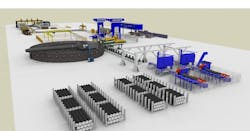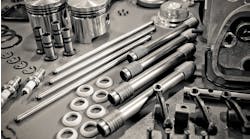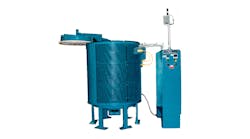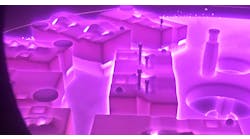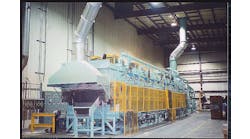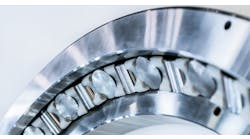Krott + Heuter, a specialty machine designer and builder, has developed a new series of machines (Type ZKSTA) for hot upsetting of fastener heads and pins, including screws and bolts. The ZKSTA machine has undergone production trials at an unnamed manufacturer of punches and ejector pins — and passed, according to the developers. The centerpiece of the design is a specially developed three-section star die that sequentially separates and isolates from each other the “insertion”, “heating-up”, “heading”, “cooling” and “discharge” operations in the hot-forming sequence. This makes it possible for the machine to reduce heading cycle times by up to 30%, they report.
Up to now, it has been customary to use dies with two opposing mountings for hot heading of fasteners (screws or bolts), ejector pins for moldmaking, and perforating pins and needles. A new pin was inserted in the upper position while the pin in the lower position was being headed. Then, the die was turned through 180°, the pin cooled down, and then it was discharged.
Insertion, cooling, and discharge all took place in the same mounting, with the result that the sum of these operations determined cycle time. Consequently, it was necessary to wait for sufficient cooling, particularly in the case of thick material, despite the fact that heating-up and heading had already been completed.
The ZKSTA series automatic heading machines feature a newly developed star die with three separately cooled mountings arranged in a star configuration. While a finished pin is being removed from the first position and a new one inserted, another pin is being inductively heated and upset simultaneously in the second position. The pin cools in the third position. The star rotates by 120° to the next position after each cycle. Now, the process that determines cycle-time is heating up, and there is no longer any need to wait through the unproductive cooling phase.
Users report that they have been able to increase output of their hot-forming lines by up to 30% thanks to the separating of the sequence for material heading, cooling and discharge.
The machine described above upsets pins of diameters between 2 and 8 mm with an upsetting force of up to 200 kN, although significantly larger dimensions and upsetting forces (up to 1,000 kN) are possible.
The ZKSTA machine’s high level of precision also allows production of fastener heads with special geometries, for example, types beveled on one side, or pins featuring various special head shapes. The automated machine also can be used for cold upsetting of softer materials, such as structural steel, aluminum, or brass.
The pins are automatically inserted, measured and upset to the precise final head dimension by means of a servo-controlled stop plate, with the result that every individual head is completely filled. The servo-hydraulically actuated upsetting cylinder can be operated power-controlled or deformation-controlled.
In contrast to conventional systems that require large quantities of hydraulic fluid, the ZKSTA does not include any external fluid supply. There is no separate tank for hydraulic fluid, and so the machine has a footprint of roughly 1.0×3.0 m.
These heading units have maintenance intervals of around 20,000 operating hours. The developers note that the ZKSTA units technically are automatic upsetting machines, and thus are not subject to European mechanical and hydraulic press legislation.


